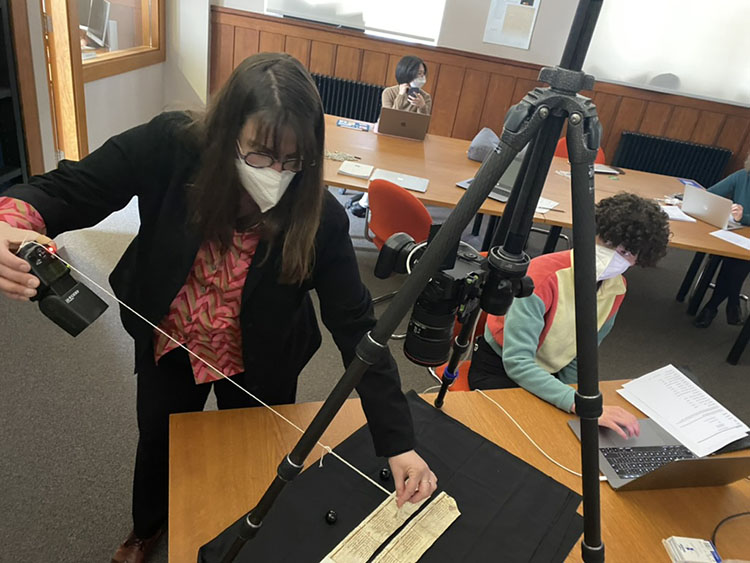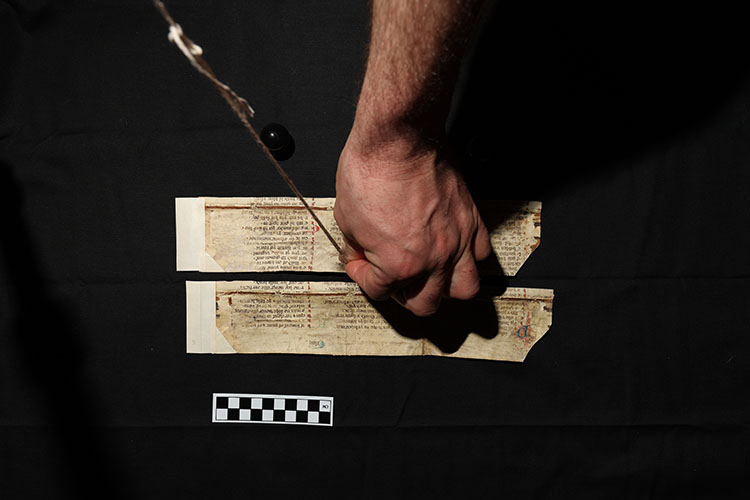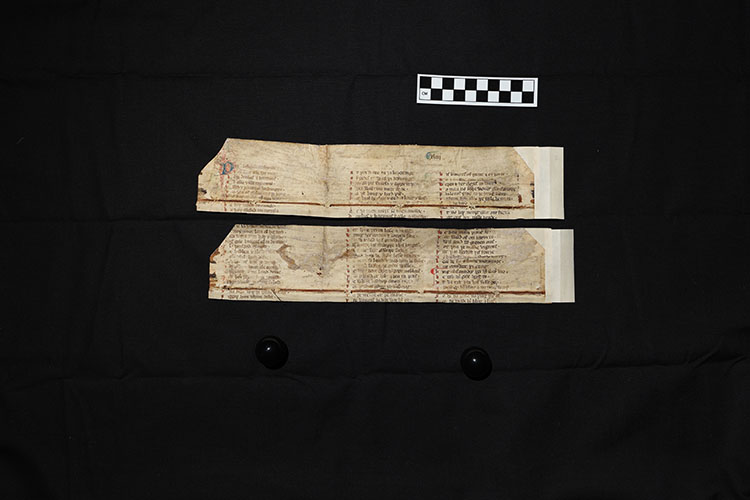RTI imaging fragments of ‘The Romances of Kyng Alisander’, strays from the Auchinleck manuscript
Continuing the series of blog posts on the recent RTI (Reflectance Transformation Imaging) workshop, Phoebe MacIndoe looks at the fragments of ‘The Romances of Kyng Alisander’.
The advantages to using digitised manuscript surrogates are clear. They offer portability, unrestricted hours of access, and a zoom function that does not require leaning perilously close to a fifteenth-century Book of Hours. However, even the clearest digital image holds the leaf behind the glass of the digital screen. We can’t hold up the static digital image to see other angles and the light is always beautifully constant across the page, lit for the fragment’s aesthetic value rather than for information.
The items I chose to image were fragments of The Romances of Kyng Alisander (msPR2065.A15) which belong to the Auchinleck manuscript (NLS Adv MS 19.2.1). These two fragments were excised from the original codex and used in a book binding, being discovered in 1949. They are small, dirty, and have a long brown line of staining where the leather was pressed to the leaf. This long stain obscures most of one line of text that has remained invisible to transcribers. The aim was to investigate along the line of the brown leather stain, to see whether any new characters could be discerned, and also along the line of the central fold, to see whether any stitching marks could be seen.

Once the RTI setup was done, and we had checked the focus and colour levels of the camera, the RTI dance (as we started to call it) began. We took it in turns to move around the full 360 degrees of the manuscript, taking around 50 images overall. Unfortunately, choreographing this constant movement took some time and, when we reached the final stage of imaging, we were slightly clumsy around the table and knocked it. This took the camera out of focus and subtly moved the tripod meaning that we had to start the imaging process all over again.

The next stage, on the following day, was to check the images were of good quality. Amongst the images of the Auchinleck fragments were shadows from my arm, shadows from the tripod leg, and one image that had a hand holding the string above the fragments. Once these images were filtered out, we edited the remainder to make the contrast slightly sharper, and then fed them through the RTI processor. In this process we also removed the images with the plastic hemispheres (integral to the process), meaning that they would no longer be in the final RTI product. As the process of making RTI images is complex and painstaking, many things can go wrong.
Once the processing had finished the composite image was there on screen. I was able to play with the light sources to examine the landscape of the fragments in depth. In contrast to regular digital images taken with the flash directly overhead, the RTI image shows the grooves and folds of the parchment along with the shadows they throw. In Dr Suzette van Haaren’s words the image “looks like the parchment feels”.

The resulting image of the Auchinleck fragments shows the dramatic topography of the fragment. The shadows of the fold move with the light to illuminate right up to the fold itself. Although these fragments do not have illuminated letters, the distinction between the red rubric, the blue decorative ink, and the brown ink, is starker. Under less direct light, the shine through from the other side of the parchment is also more obvious, meaning that the decorated blue ‘A’ in the centre right of the upper fragment is clearer. When the direction of the light is moved around, the glue stains are easier to distinguish from the worn parts of the pages. The glue stains appear very brown under less direct light while the worn sections along the fold line are whiter.
Unfortunately, the light could not make the writing beneath the leather staining more apparent; however, I will continue to attempt to transcribe the minims that can be seen under the line. With the aid of the specular enhancement function some marks that could be evidence of stitching are visible on the fold line, including a possible channel for cording. These are not visible in person nor on the standard digital image.
Given that the set up for the imaging process was simple enough for a group of students to image several items each over the course of only a few hours, the discoveries are significant. Not only do we now have higher quality images that better display the tactile properties of the manuscript leaf, but we can also see entirely new elements of the items we imaged.
Phoebe MacIndoe